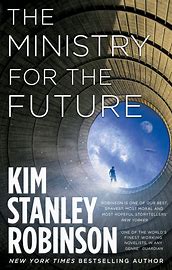The Ministry of the Future
Prashant Vaze's review of Kim Stanley Robinson's novel about an organisation, established under the Paris Agreement, whose mission is to advocate for the world's future generations of citizens as if their rights are as valid as the present generation's

Published by Orbit Books, 2021
The climate fiction novel The Ministry for the Future is a 550-page journey through the impacts of climate change routed through ecological economics, eco-terrorism, new monetary theory, geoengineering with a thin veneer of a storyline.
The book’s action takes place in the decades after 2025. The two protagonists are Frank May, an aid-worker turned-eco-terrorist and Mary Murphy, a former Irish politician who heads the ‘Ministry for the Future (MfF)’. The MfM is a UN body established to defend the interests of future generations. Its way of working is an imaginative reversal of UN agencies usual sclerotic toothlessness. It does pretty much anything it likes; its initiatives include running a crack black ops team and developing a co-operatively owned alternative to Facebook.
The book starts with the harrowing account of a lethal Indian heat-wave that kills twenty million seen through Frank eyes, “Four more died that night. In the morning, the sun again rose like the blazing furnace of heat that it was.” This chapter contains the book’s most powerful passages. The experience leaves Frank broken and suffering a mixture of PTSD and survivor syndrome, prompting a career switch to eco-terrorism. He holds Mary hostage, is captured and jailed, starting their half-hearted and never consummated romance.
As well as the narrative chapters centred around Mary and Frank, there is an array of interlude chapters, including first-person accounts by the sun or a carbon atom, chapter- length essays on climate science and wealth inequality. One chapter commences by defining ideology as “… An imaginary relationship to a real situation”. Another consists of a Socratic dialogue, “Today we’re here to inquire who actually enacts the world’s economy – who are the ones to make it all go, so to speak.” This is followed by a series of short paragraphs often just a word or two long. These are often quite interesting, but they break up the book's flow and are only tangentially relevant to the story.
So how does it read as a piece of futurology and as a piece of fiction?
As a piece of futurology, it’s certainly brimming with ideas. The world’s reaction to the Indian tragedy unleashes a fit of policy experimentation that would delight George Monbiot or AOC. In India, a rainbow coalition government reorientates the economy to renewable energy, regenerative agriculture, Indian style socialism, and land ownership reform. It embarks on a massive programme of geoengineering using its air force to release aerosols to replicate the Pinatubo eruption’s cooling effect.
Geoengineering is a recurrent theme of the novel. Eccentric billionaires pump meltwater from below glaciers to the Antarctic’s centre to slow the sliding ice sheets. But this proves an un-drop in the ocean and is insufficient to reverse climate change’s physical impacts and the escalating flow of refugees from Africa to Europe.
The book, perhaps controversially, accepts without much moral comment the rise of eco- terrorist factions like the Children of Kali. Early in the book, they assassinate fossil fuel and armament industry executives. Later, they storm Davos’ World Economic Forum and hold the world’s business and political leaders hostage. The captives are subjected to a PowerPoint teach-in about how they are screwing up the world – with predictably little impact. But this scene, like several others, fails to hit the mark partly because of the poor quality of the characterisation and writing. The unnamed Master of the Universe narrator blandly recounts, “...And the security people were suddenly seen to be not the same security people, these new ones were in masks guarding us in a different sense than we had been guarded before.” It’s not just Robinson’s writing that is half-hearted and lacking conviction. So too are his characters. His terrorists are incapable of the visceral cruelty of the Khmer Rouge or Gitmo. It’s as though being an environmentalist denies you the imagination to waterboard.
Through the book there is a steady escalation in aggression against capitalism. Swiss bank accounts are hacked. Borrowers refuse to pay their lenders interest. A new type of skunk warfare develops where the terrorists deploy pebble-mob missiles to destroy military kit and buildings used by repressive regimes – effectively neutering nation states’ air forces and navies.
Robinson also has a go at imagining the decarbonising of the economy through an escalating global carbon tax, Georgist land taxes (a wealth tax) and the ‘carbon coins’ - a new interest- bearing cryptocurrency. The account of the latter is fascinating but also somewhat confused. The idea is that a coalition of central banks issue currency backed by carbon emissions avoided. This is akin to an action the Bank of International Settlements (BIS) is already undertaking. But Robinson complicates this by bringing in carbon Quantitative Easing (basically a carbon money-tree) loosely based around the QE policy the US Fed developed following the great financial crash. This transfers wealth to anyone removing carbon, like forest managers maintaining tree cover or Saudi Arabian forbearance in extracting oil.
But do the book’s big ideas make sense? These ideas are intriguing and imaginative, but the details don’t quite work.
The Pinotoba eruption is thought to have released 17 million tonnes of aerosols; replicating this would need hundreds of thousands of aircraft sorties. Could the Indian air force do this?
The idea of carbon coins is potentially compelling. In the book, Mary Murphy persuades the BIS and central banks to issue long-dated bonds which underpin the digital / blockchain carbon coin which appear to be exchangeable for existing currencies. But the book misunderstands the way the original QE operated: central banks bought government bonds from banks to finance Keynesian spending programmes, they didn’t sell bonds to investors. Robinson’s idea doesn’t work economically since emissions avoidance does not provide the near-term financial returns needed to pay the interest on the bond, and printing money to pay the coupon could have perverse stimulatory impacts. Governments rather than central banks operate stimulus programmes in the real world - witness Obama’s ARRA or the European Union’s Build Back Better. The Build Back Better concept, espoused by many academics, NGOs, and real former Irish politicians called Mary, reorientate public spending to carbon mitigation and nature restoration. Central banks play an important but different role in buying government debt if the government has to run a deficit. A somewhat wider than current role for central banks in climate change was espoused in Glasgow’s COP26 by the chair of the central banks’ green network, or which I set out here.
In common with Robinson’s earlier books (Mars trilogy and the excellent New York 2140), there is a fascinating display of technological and ecological change. The book brims with ideas: airships replace planes, wildlife corridors provide contiguous ecosystems for large animals to flourish.
But as a novel, the book is clunky. It suffers from too much telling rather than showing with long passages of text that explain concepts rather than weaving it through character conflicts. John Lanchester’s The Wall is the exact opposite displaying Britain’s brutally repressive response to future climate change without delving into the nitty gritty engineering detail of barricading the UK against sea-level rise and refugees. Except for Mary and Frank, none of the characters are well developed or sufficiently rounded to evoke the readers’ sympathy even if they die violently.
Most of the ideas in the book will seem blindingly obvious to the readers of Green Reads. Climate fiction’s function is to help us imagine how the world could be if we adjusted our ways and to warn of the threats if we don’t. Robinson provides a fascinating, initially bleak and then somewhat hopeful account of socio-economic development over the next few decades, even if his skills as a storyteller aren’t so much in evidence as in earlier books.
Prashant Vaze works in a climate finance NGO and is author of the climate fiction novel The Rising Tide



